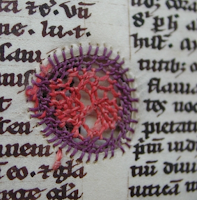 |
| Christine de Pisan, 1407 (Wikimedia Commons | Public Domain) |
When we think of medieval monastic scribes it's likely that a tonsured male figure comes to mind. But women were also scribes! There are written records of this, such as necrologies that identify these women, and archaeological evidence that also points to these female artists.
The latest evidence to surface is the discovery of lapis lazuli in the teeth of a female monastic who lived at the monastery at Dalheim between 997 and 1162.
Why is this discovery of lapis lazuli in a nun's teeth so remarkable? This pigment was quite rare and therefore only the best artists were allowed access. Its use by female scribes indicates that they were just as highly skilled as their male counterparts.
 |
| Silk repaired manuscript |
 |
| Alison on the right. |
While at Oxford we were allowed access to the Bodleian library. Access first required a swearing in (in Latin) by a robed librarian and signing of a pledge to treat the books with utmost care. Each item we wanted to view had to be brought from a storage area--no wandering the stacks here! All codices had to be handled while wearing white cotton gloves, and the pages were held open by beads resembling rosaries. It was a religious experience for our class of twelve, all who happened to be women.
 |
| Image from Wikipedia |
With the plethora of books so readily available to us today, it's easy to forget how precious these volumes were throughout history, and how much labor was required to produce them.











How interesting! Thank you for sharing this. And I wonder why lapis lazuli? I'm sure there were other materials, but maybe because it is such a soft medium it worked.
ReplyDeleteVery interesting post, Lexa. I did not know there were female scribes.
ReplyDelete